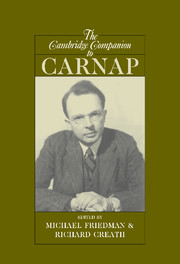Book contents
- Frontmatter
- Introduction: Carnap’s revolution in philosophy
- 1 Carnap’s intellectual development
- 2 Geometrical leitmotifs in Carnap’s early philosophy
- 3 Carnap and Frege
- 4 Carnap and Husserl
- 5 Carnap, Russell, and the external world
- 6 The Aufbau and the rejection of metaphysics
- 7 Carnap and the Vienna Circle: rational reconstructionism refined
- 8 Carnap and modern logic
- 9 Tolerance and logicism: logical syntax and the philosophy of mathematics
- 10 Carnap’s quest for analyticity: the Studies in Semantics
- 11 Carnap on the rational reconstruction of scientific theories
- 12 Carnap on probability and induction
- 13 Carnapian pragmatism
- 14 Quine’s challenge to Carnap
- Bibliography
- Index
5 - Carnap, Russell, and the external world
Published online by Cambridge University Press: 28 April 2008
- Frontmatter
- Introduction: Carnap’s revolution in philosophy
- 1 Carnap’s intellectual development
- 2 Geometrical leitmotifs in Carnap’s early philosophy
- 3 Carnap and Frege
- 4 Carnap and Husserl
- 5 Carnap, Russell, and the external world
- 6 The Aufbau and the rejection of metaphysics
- 7 Carnap and the Vienna Circle: rational reconstructionism refined
- 8 Carnap and modern logic
- 9 Tolerance and logicism: logical syntax and the philosophy of mathematics
- 10 Carnap’s quest for analyticity: the Studies in Semantics
- 11 Carnap on the rational reconstruction of scientific theories
- 12 Carnap on probability and induction
- 13 Carnapian pragmatism
- 14 Quine’s challenge to Carnap
- Bibliography
- Index
Summary
As he approached his 71st birthday Carnap wrote a warm letter to Bertrand Russell (1872–1970), who was about to turn 90. Dated 12 May 1962, it notes that Russell's “books had indeed a stronger influence on my philosophical thinking than those of any other philosopher” and mentions “the inspiring effect on me of your appeal for a new method in philosophy, on the last pages of your book Our Knowledge of the External World“ (Russell, 1967–1969, 1998, 626). Russell responded a few weeks later in equally affectionate terms: “I believe that your efforts to bring clarity and precision to philosophy will have an everlasting effect on the thinking of men . . . Nothing would be more fitting than that you should successfully realise your theory of inductive probability” (Russell, 1967–1969, 1998, 627; cf. ASP RC 090-06-07).
Here we have the final exchange in a correspondence that stretched back to 1921, when Carnap sent Russell a copy of his doctoral dissertation on space (Carnap, 1922). To appreciate its significance, we need to first briefly review Russell's intellectual career. He is widely seen as the most important early figure of analytic philosophy, who, along with G. E. Moore in the late 1890s, broke with the Hegelian idealism of Bradley and McTaggart and fashioned a new pluralistic and realistic approach to traditional metaphysical and epistemological disputes.
- Type
- Chapter
- Information
- The Cambridge Companion to Carnap , pp. 106 - 128Publisher: Cambridge University PressPrint publication year: 2007
- 8
- Cited by

